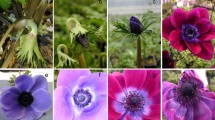Abstract
The response to incompatible (self) pollination in rye (Secale cereale L.) includes the rapid deposition in the germinating pollen grain and pollen tube of a substance that stains with aniline blue, resorcin blue and calcofluor, and in these respects resembles callose. This substance has been isolated and analysed by acid hydrolysis and methylation as well as specific enzyme hydrolysis. It contains a glucan component with 1,4-β-glucosidic and 1,3-β-glucosidic linkages within the same linear chains. The proportion of 1,4-to 1,3-glucosidic linkages in the preparation is 77∶9.
Similar content being viewed by others
Abbreviations
- DMSO:
-
dimethylsulphoxide
References
Albersheim, P., Nevins, D.J., English, P.D., Karr, A. (1967) A method for the analysis of sugars in plant cell-wall polysaccharides by gasliquid chromatography. Carbohydr. Res.5, 340–345
Anderson, M.A., Cook, J.A., Stone, B.A. (1978) Enzymatic determination of 1,3 1,4-β-glucans in barley grain and other cereals. J. Inst. Brew. London84, 233–239
Barras, D.R., Stone, B.A. (1969) β-1,3-Glucan hydrolyses fromEuglena gracilis I. The nature of the hydrolases. Biochim. Biophys. Acta191, 329–341
Barskaya, E.I., Balina, N.V. (1971) The role of callose in plant anthers. Sov. Plant Physiol.18, 605–610
Bell, D.J., Northcote, D.H. (1950) The structure of a cell wall polysaccharide of baker's yeast. J. Chem. Soc. 1944–1947
Buchala, A.J., Fraser, C.G., Wilkie, K.C.B. (1972) Extraction of hemicellulose from oat tissues during the process of delignification. Phytochemistry11, 1249–1254
Buchala, A.J., Wilkie, K.C.B. (1973) Total hemicelluloses from wheat of different stages of growth. Phytochemistry12, 499–505
Burke, D., Kaufman, P.B., McNeil, M., Albersheim, P. (1974) The structure of plant cell walls. VI. A survey of the walls of suspension cultured monocots. Plant Physiol.54, 109–115
Clarke, A.E., Knox, R.B. (1978) Cell recognition in flowering plants. Q. Rev. Biol.53, 3–28
Clarke, A.E., Knox, R.B. (1979) Plants and immunity. Dev. and Comp. Immunol.3, 571–589
Clarke, A.E., Stone, B.A. (1963) Chemistry and biochemistry ofβ-1,3 glucans. Rev. Pure Appl. Chem.13, 134–156
Conrad, H.E. (1962) Methylation of carbohydrates with methyl sulphinyl anion and methyl iodide in dimethyl sulphoxide. In: Methods in carbohydrate chemistry, (Whistler, R.L., Wolfrom, M.L., eds.) Academic Press, New York
Cresti, M., Van Went, J.L. (1976) Callose deposition and plug formation inPetunia pollen tubes, in situ. Planta133, 35–40
Eschrich, W. (1954) Ein Beitrag zur Kenntnis der Kallose. Planta44, 532–542
Eschrich, W., Eschrich, B. (1964) Das Verhalten isolierter Callose gegenüber wäßrigen Lösungen. Ber. Deutsch. Bot. Ges.77, 329–331
Faulkner, G., Kimmins, W.C., Brown, R.G. (1973) The use of fluorochromes for the identification of β(1→3) glucans. Can. J. Bot.51, 1503–1504
Fulcher, R.G., Setterfield, G., McCully, M.E., Wood, P.J. (1977) Observations on the aleurone layer. II. Fluorescence microscopy of the aleurone/sub-aleurone junction with emphasis on possible β-1,3-glucan deposition in barley. Aust. J. Plant Physiol.4, 1
Hakomori, S. (1964) A rapid permethylation of glycolipid and polysaccharide catalyzed by methylsulfinyl carbonion in dimethyl sulfoxide. J. Biochem.55, 205–208
Herth, W., Franke, W.W., Bittiger, H., Kuppel, R., Keilich, G. (1974) Alkali-resistant fibrils of β-1,3- and β-1,4-glucans: structural polysaccharides in the pollen tube wall ofLilium longiflorum. Cytobiologie9, 344–367
Heslop-Harrison, J. (1977) The biochemistry of self-incompatibility in the grasses. In: Incompatibility in angiosperms, pp. 95–96, Nettancourt, D. de, ed. Springer, Berlin Heidelberg New York
Heslop-Harrison, J. (1978) Genetics and physiology of angiosperm incompatibility systems. Proc. Roy. Soc. Lond. B202, 73–92
Hughes, J., McCully, M.E. (1975) The use of an optical brightener in the study of plant structure. Stain Technol.50, 319
Kessler, G. (1958) Zur Charakterisierung der Siebröhren-Kallose. Ber. Schweiz. Bot. Ges.68, 5–43
Lindberg, B., Lönngren, J., Thompson, J.L. (1972) Structural studies of theKlebsiella type 9 capsular polysaccharide. Carbohydr. Res.25, 49–57
Linskens, H.F., Esser, K. (1957) Über eine spezifische Anfärbung der Pollenschläuche in Griffel und die Zahl der Kallosepfropfen nach Selbstung und Fremdung. Naturwissenschaften44, 16
Lonngren, J., Pilotti, A. (1976) Gas-liquid chromatography of partially methylated alditols as their acetates II. Acta Chem. Scand.25, 1144–1145
Lundquist, A. (1954) Studies on self-sterility in rye,Secale cereale L. Hereditas40, 278–294
Lundquist, A. (1956) Self-incompatibility in rye. I. Genetic control in the diploid. Hereditas42, 293–348
Lundquist, A. (1961) A rapid method for the analysis of incompatibilities in grasses. Hereditas47, 705–707
Morrison, I.M. (1974) Changes in the hemicellulosic polysaccharides of rye grass with increasing maturity. Carbohydr. Res.36, 45–51
Morrison, I.M. (1975) Delignification and hemicellulose extraction of cell walls ofLolium perenne andTrifolium pratense. Phytochemistry14, 505–508
Parrish, R.W., Perlin, A.S., Reese, E.T. (1960) Selective enzymolysis of poly-β-D-glucans and the structure of the polymers. Can. J. Chem.38, 2094–2104
Reese, E.T., Mandels, M. (1959) β-D-1,3 glucanases in fungi. Can. J. Microbiol.5, 173–185
Ramming, D.W., Heinricks, H.A., Richardson, P.E. (1973) Sequential staining of callose by aniline blue and lacmoid for fluorescence and regular microscopy on a durable preparation of the same specimen. Stain Technol.48, 133–134
Reynolds, J.D., Dashek, W.V. (1976) Cytochemical analysis of callose localization inLilium longiflorum pollen tubes. Ann. Bot.40, 409–416
Smith, M.M., McCully, M.E. (1978) A critical evaluation of the specificity of aniline blue induced fluorescence. Protoplasma95, 229–254
Straumanis, M.E. (1953) Lattice parameters expansion coefficients, and atomic and molecular weights. X-Ray techniques for precesion determination. Anal. Chem.25, 700–704
Trevelyan, N.E., Proctor, D.P., Harrison, J.W. (1950) Detection of sugars on paper chromatograms. Nature (London)166, 444
Wood, P.J., Fulcher, R.G. (1978) The interaction of some dyes with cereal β-glucans. Cereal Chem.55, 952–966
Author information
Authors and Affiliations
Rights and permissions
About this article
Cite this article
Vithanage, H.I.M.V., Gleeson, P.A. & Clarke, A.E. The nature of callose produced during self-pollination inSecale cereale . Planta 148, 498–509 (1980). https://doi.org/10.1007/BF02395321
Received:
Accepted:
Issue Date:
DOI: https://doi.org/10.1007/BF02395321




